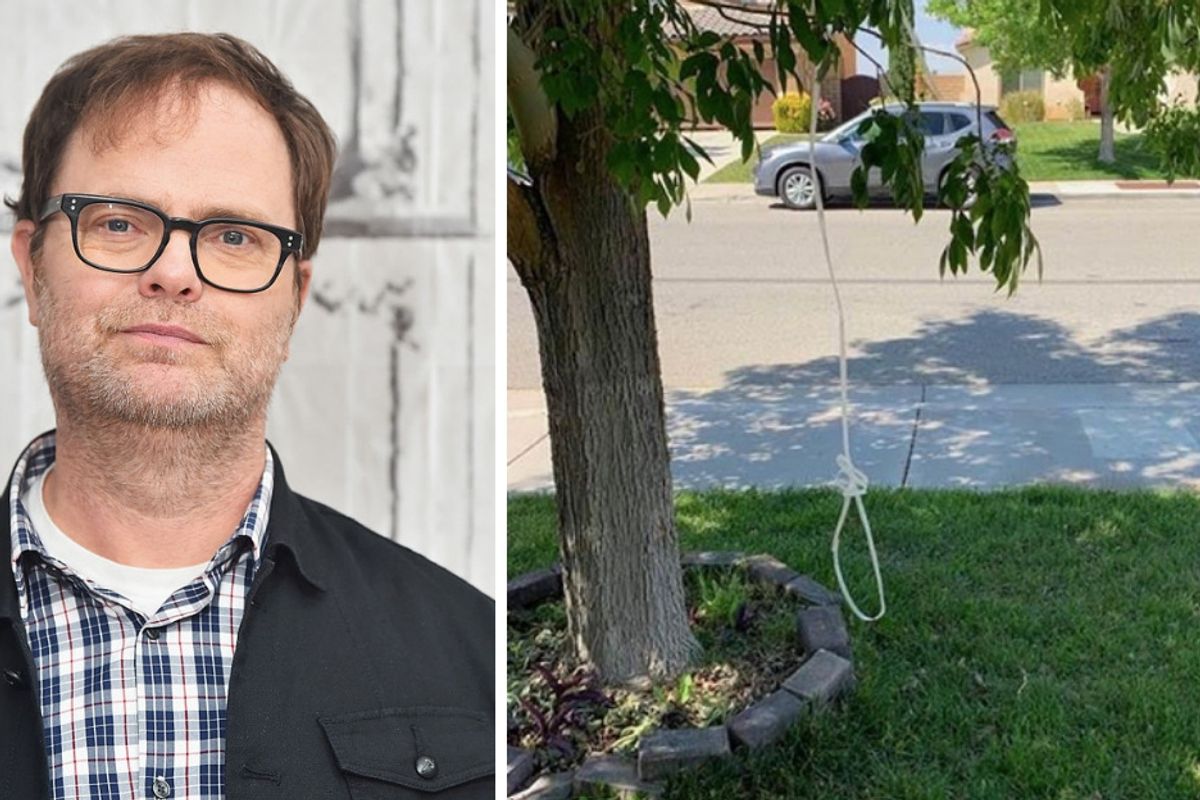Rainn Wilson slams racism denial with a 'chilling' photo of a noose hanging in his friend's yard.

Michael Loccisano/Getty (left) Rainn Wilson/Instagram (right)
This photo should strike terror in the heart of all of us, as it symbolizes a heinous piece of American history.
Rainn Wilson, the actor best known for playing Dwight Schrute on NBC's "The Office," has taken to Instagram with a photo and a story that reminds us that racism in America is unfortunately alive and well.
The photo shows a tree in the front yard of a suburban L.A. home with a noose hanging from one of its branches.
"So my friend Jamey texted me this photo," Wilson wrote. "Looks pretty innocent at first, right? But when you learn that he and his sister are African American, the photo turns instantly chilling. This was hung in a tree in her front yard in suburban Los Angeles, to be found by her seventeen year-old daughter."
Imagine being a 17-year-old Black American, stepping out your front door, and facing this scene. Would you feel safe? Would you feel protected? Would you feel that America is a place where racism isn't allowed to thrive?
You might feel understandably threatened. You might call the police with your concerns. That's what Wilson's friend did.
"When the police were called they said, essentially, 'what's the big deal?'" Wilson shared. "Yolanda lost it. What's the big deal? Well, officer, the noose is the symbol of lynching which was used to hang thousands of African Americans, especially by the Klan. Granted, this is a pretty lame noose. Might have been made by some local kids or something. Who knows. But the fact is it is as strong a symbol of racial hatred, violence and oppression as a Swastika."
Yes, this is 2019. And we still have to explain the history of lynching in America and why a noose hanging in a Black person's yard is, in fact, a big deal.
Wilson explained that far too many Americans are in denial about racism in the U.S.
"Many folks are in denial about the extent to which racism exists in our country in 2019," Wilson continued. "Just ask a Black Person. They will tell you stories."
(For the record, asking random Black people to share their stories of racism for your own education isn't actually a great idea. Basically, that's like asking people to open their wounds so you can look inside to make sure they're actually hurt. There are countless stories of racism that people have graciously shared online and in books that you can read without asking for extra emotional labor to be done. Alternatively, try truly befriending some Black people and wait for them to feel comfortable enough with you to open up and share.)
Wilson shared another story from his friend:
"Jamey told me today that last year, while playing golf, he was looking for his ball in the brush and a white guy who wanted to play through called out 'Hey, you can hurry up, we don't have you picking cotton anymore!' Not sure if he was trying to be funny or not but literally Jamey's great grandfather was an ACTUAL SLAVE on a plantation and was regularly beaten there. That's not that long ago. Great grandfather. And, perhaps, a relative or two of Jamey's were lynched. Or saw a lynching. Or heard of a lynching. And now, his niece gets to be reminded of what hate looks like. Right in her own front yard in suburban LA."
If your first response is to assume this story is a 'hoax,' think long and hard before sharing that thought.
People who want to deny that racism is a real thing are already twisting themselves into knots trying to call this story a hoax. Here's the problem with that:
1) Hanging a noose in a Black person's yard is racist no matter which way you slice it. Even if it was set up as some silly schoolyard joke, the joke itself is racist and harmful, and obliviousness to that fact is a clear manifestation of racism in our society.
2) Assuming or implying that a Black person you don't know would set this scene up themselves to get attention is a racist assumption. If you believe that Black people make these things up more often than not, then a) You clearly aren't close to very many Black people, and b) Your mental image of Black people is racist. If your automatic presumption is that this can't be true, then you you haven't been paying attention to the last several hundred of years of American history and/or you are looking at that history through a lens of white supremacy.
The impulse to automatically question or challenge a Black person's story is a racist impulse that needs to be checked.
And checking it really isn't that complicated. It's not hard to choose to listen to thousands of similar stories and believe them. It's not hard to recognize that racism didn't just magically disappear with the Civil Rights Act, especially since large numbers of people actively opposed its passage. It's past time to shift the benefit of the doubt toward the groups who have been demonstrably abused and silenced in our country, and to speak out against racism whenever we see it rear its head.
- Rainn Wilson gave a commencement speech to rich kids — and he ... ›
- Rainn Wilson sits by fan on a plane - Upworthy ›
- Rainn Wilson joins the Upworthy Book Club - Upworthy ›



 In a 4-day model, kids often (but not always) receive less instructional time. Photo by
In a 4-day model, kids often (but not always) receive less instructional time. Photo by 


 A woman looking at her phone on the toilet.via
A woman looking at her phone on the toilet.via  A man looking at his phone on the toilet.via
A man looking at his phone on the toilet.via 